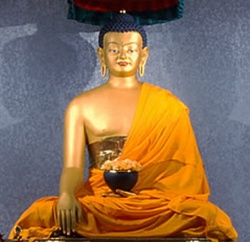Difference between revisions of "Pāramitā"
| Line 3: | Line 3: | ||
[[Paramita]]: Refers to the [[six practices]], the [[perfection]] of which ferries one beyond the sea of [[suffering]] and {{Wiki|mortality}} to [[Nirvana]]. | [[Paramita]]: Refers to the [[six practices]], the [[perfection]] of which ferries one beyond the sea of [[suffering]] and {{Wiki|mortality}} to [[Nirvana]]. | ||
| + | |||
The [[six Paramitas]] are the following: | The [[six Paramitas]] are the following: | ||
| + | |||
:(1) [[Dana]], [[charity]] or giving, including the bestowing of [[truth]] on others; | :(1) [[Dana]], [[charity]] or giving, including the bestowing of [[truth]] on others; | ||
:(2) [[Sila]], keeping the [[discipline]]; | :(2) [[Sila]], keeping the [[discipline]]; | ||
| Line 22: | Line 24: | ||
: The term [[pāramitā]], commonly translated as "[[perfection]]," has two etymologies. The first derives it from the [[word]] [[parama]], meaning “[[highest]],” “[[most distant]],” and hence, “chief,” “[[primary]],” “[[most excellent]].” Hence, the substantive can be rendered “[[excellence]]” or “[[perfection]].” This reading is supported by the [[Madhyāntavibhāga]] (V.4), where the twelve excellences (''[[parama]]'') are associated with the ten [[perfections]] ([[pāramitā]]). | : The term [[pāramitā]], commonly translated as "[[perfection]]," has two etymologies. The first derives it from the [[word]] [[parama]], meaning “[[highest]],” “[[most distant]],” and hence, “chief,” “[[primary]],” “[[most excellent]].” Hence, the substantive can be rendered “[[excellence]]” or “[[perfection]].” This reading is supported by the [[Madhyāntavibhāga]] (V.4), where the twelve excellences (''[[parama]]'') are associated with the ten [[perfections]] ([[pāramitā]]). | ||
| − | A more creative yet widely reported {{Wiki|etymology}} divides [[pāramitā]] into [[pāra]] and [[mita]], with [[pāra]] meaning "[[beyond]]," "the [[further bank]], [[shore or boundary]],” and [[mita]], meaning “[[that which has arrived]],” or [[ita]] meaning “[[that which goes]].” [[Pāramitā]], then means “[[that which has gone beyond]],” “[[that which goes beyond]],” or “[[transcendent]].” This reading is reflected in the {{Wiki|Tibetan}} translation ''[[pha rol tu phyin pa]]'' (“[[gone to the other side]]”). | + | A more creative yet widely reported {{Wiki|etymology}} divides [[pāramitā]] into [[pāra]] and [[mita]], with [[pāra]] meaning "[[beyond]]," "the [[further bank]], [[shore or boundary]],” and [[mita]], meaning “[[that which has arrived]],” or [[ita]] meaning “[[that which goes]].” |
| + | |||
| + | [[Pāramitā]], then means “[[that which has gone beyond]],” “[[that which goes beyond]],” or “[[transcendent]].” This reading is reflected in the {{Wiki|Tibetan}} translation ''[[pha rol tu phyin pa]]'' (“[[gone to the other side]]”). | ||
==[[Theravāda]] [[Buddhism]]== | ==[[Theravāda]] [[Buddhism]]== | ||
| − | [[Theravāda | + | [[Theravāda Buddhism]]'s teachings on the [[pāramitās]] can be found in late [[Wikipedia:canonical|canonical]] [[Books]] and post-canonical commentaries. |
==={{Wiki|Canonical}} sources=== | ==={{Wiki|Canonical}} sources=== | ||
| Line 50: | Line 54: | ||
===Historicity=== | ===Historicity=== | ||
| − | The [[Theravādin]] teachings on [[pāramitās]] can be found in [[Wikipedia:canonical|canonical]] [[Books]] ([[Jātaka]], [[Apadāna]], [[Buddhavaṃsa]], [[Cariyāpiṭaka]]) and post-canonical commentaries which were written to supplement the [[Pāli Canon]] at a later [[time]], and thus they are not an original part of the [[Theravādin]] teachings. The oldest parts of the [[Sutta Piṭaka]] (for example, [[Majjhima Nikāya]],[[ Digha Nikāya]], [[Saṃyutta Nikāya]] and the [[Aṅguttara Nikāya]]) do not have any mention of the [[pāramitās]] as a category (though they are all mentioned individually). | + | The [[Theravādin]] teachings on [[pāramitās]] can be found in [[Wikipedia:canonical|canonical]] [[Books]] ([[Jātaka]], [[Apadāna]], [[Buddhavaṃsa]], [[Cariyāpiṭaka]]) and post-canonical commentaries which were written to supplement the [[Pāli Canon]] at a later [[time]], and thus they are not an original part of the [[Theravādin]] teachings. |
| + | |||
| + | The oldest parts of the [[Sutta Piṭaka]] (for example, [[Majjhima Nikāya]],[[ Digha Nikāya]], [[Saṃyutta Nikāya]] and the [[Aṅguttara Nikāya]]) do not have any mention of the [[pāramitās]] as a category (though they are all mentioned individually). | ||
| + | |||
| + | Some {{Wiki|scholars}} even refer to the teachings of the [[pāramitās]] as a semi-[[Mahāyāna]] [[teaching]] which was added to the [[scriptures]] at a later [[time]], in order to appeal to the interests and needs of the lay {{Wiki|community}} and to popularize their [[religion]]. However, these [[views]] rely on the early [[scholarly]] presumption of [[Mahāyāna]] originating with [[religious]] [[devotion]] and appeal to laity. | ||
| − | + | More recently, {{Wiki|scholars}} have started to open up early [[Mahāyāna]] {{Wiki|literature}} which is very {{Wiki|ascetic}} and expounds the {{Wiki|ideal}} of the [[Monk]]'s [[Life]] in the {{Wiki|forest}}. Therefore, the practice of the [[pāramitās]] is closer to the ideals of the {{Wiki|ascetic}} [[tradition]] of the [[śramaṇa]] in [[Buddhism]]. | |
===[[Traditional]] practice=== | ===[[Traditional]] practice=== | ||
| − | [[Bodhi]] (2005) maintains that, in the earliest [[Buddhist texts]] (which he identifies as the first four [[nikāyas]]), those seeking the [[extinction]] of [[Suffering]] ([[Nibbana]]) pursued the [[Noble Eightfold Path]]. As [[time]] went on, a backstory was provided for the multi-[[Life]] [[development]] of The [[Buddha]]; as a result, the | + | [[Bodhi]] (2005) maintains that, in the earliest [[Buddhist texts]] (which he identifies as the first four [[nikāyas]]), those seeking the [[extinction]] of [[Suffering]] ([[Nibbana]]) pursued the [[Noble Eightfold Path]]. As [[time]] went on, a backstory was provided for the multi-[[Life]] [[development]] of The [[Buddha]]; as a result, the [[ten perfections]] were identified as part of the [[path for the Bodhisattva]] ([[Pāli]]: [[Bodhisatta]]). Over subsequent centuries, the [[pāramīs]] were seen as being significant for aspirants to both [[Buddhahood]] and [[arahantship]]. Thus, [[Bodhi]] (2005) summarizes: |
: It should be noted that in established [[Theravāda tradition]] the [[pāramīs]] are not regarded as a [[discipline]] peculiar to candidates for [[Buddhahood]] alone but as practices which must be fulfilled by all aspirants to [[Enlightenment]] and [[deliverance]], whether as [[Buddhas]], [[paccekabuddhas]], or [[disciples]]. | : It should be noted that in established [[Theravāda tradition]] the [[pāramīs]] are not regarded as a [[discipline]] peculiar to candidates for [[Buddhahood]] alone but as practices which must be fulfilled by all aspirants to [[Enlightenment]] and [[deliverance]], whether as [[Buddhas]], [[paccekabuddhas]], or [[disciples]]. | ||
| Line 63: | Line 71: | ||
What distinguishes the supreme [[Bodhisattva]] from aspirants in the other [[two vehicles]] is the {{Wiki|degree}} to which the [[pāramīs]] must be cultivated and the length of [[time]] they must be pursued. But the qualities themselves are [[universal]] requisites for [[deliverance]], which all must fulfill to at least a minimal {{Wiki|degree}} to [[merit]] the [[fruits]] of the liberating [[path]]. | What distinguishes the supreme [[Bodhisattva]] from aspirants in the other [[two vehicles]] is the {{Wiki|degree}} to which the [[pāramīs]] must be cultivated and the length of [[time]] they must be pursued. But the qualities themselves are [[universal]] requisites for [[deliverance]], which all must fulfill to at least a minimal {{Wiki|degree}} to [[merit]] the [[fruits]] of the liberating [[path]]. | ||
[[File:4.jpg|thumb|250px|]] | [[File:4.jpg|thumb|250px|]] | ||
| − | |||
| − | + | ||
| + | ==[[Mahāyāna Buddhism]]== | ||
| + | |||
| + | In [[Mahāyāna Buddhism]], the [[Prajñapāramitā Sūtras]], the [[Lotus Sutra]] (Skt., [[Saddharma Puṇḍarīka Sūtra]]), and a large number of other texts, list the [[six perfections]] as (original terms in [[Sanskrit]]): | ||
# [[Dāna pāramitā]]: [[Generosity]], giving of oneself ([[布施波羅蜜]]; in [[Wylie]] [[Tibetan]], [[sbyin-pa]]) | # [[Dāna pāramitā]]: [[Generosity]], giving of oneself ([[布施波羅蜜]]; in [[Wylie]] [[Tibetan]], [[sbyin-pa]]) | ||
| Line 76: | Line 86: | ||
Note that this list is also mentioned by the [[Theravāda]] commentator [[Dhammapala]], who says it is {{Wiki|equivalent}} to the above list of ten. | Note that this list is also mentioned by the [[Theravāda]] commentator [[Dhammapala]], who says it is {{Wiki|equivalent}} to the above list of ten. | ||
| − | In the [[Ten Stages]] ([[ | + | In the [[Ten Stages]] ([[Daśabhūmika Sutra]]), four more [[pāramitās]] are listed: |
: 7. [[Upāya pāramitā]]: [[skillful means]] | : 7. [[Upāya pāramitā]]: [[skillful means]] | ||
| Line 82: | Line 92: | ||
: 9. [[Bala pāramitā]]: [[spiritual Power]] | : 9. [[Bala pāramitā]]: [[spiritual Power]] | ||
: 10. [[Jñāna pāramitā:]] [[Knowledge]] | : 10. [[Jñāna pāramitā:]] [[Knowledge]] | ||
| + | |||
| + | |||
==[[Tibetan Buddhism]]== | ==[[Tibetan Buddhism]]== | ||
[[File:46cc81e.jpg|thumb|250px|]] | [[File:46cc81e.jpg|thumb|250px|]] | ||
| + | |||
According to the {{Wiki|perspective}} of [[Tibetan Buddhism]], [[Mahāyāna]] practitioners have the choice of two practice [[paths]]: | According to the {{Wiki|perspective}} of [[Tibetan Buddhism]], [[Mahāyāna]] practitioners have the choice of two practice [[paths]]: | ||
Revision as of 02:31, 29 September 2015
Pāramitā (Pāli; Sanskrit; Devanagari: पारमिता) or pāramī (Pāli) is "perfection" or "completeness." In Buddhism, the pāramitās refer to the perfection or culmination of certain virtues. In Buddhism, these virtues are cultivated as a way of purification, purifying Karma and helping the aspirant to live an unobstructed Life, while reaching the goal of Enlightenment.
Paramita: Refers to the six practices, the perfection of which ferries one beyond the sea of suffering and mortality to Nirvana.
The six Paramitas are the following:
- (1) Dana, charity or giving, including the bestowing of truth on others;
- (2) Sila, keeping the discipline;
- (3) Ksanti, patience under suffering and insult;
- (4) Virya, zeal and progress;
- (5) Dhyana, meditation or contemplation;
- (6) Prajna, wisdom, the power to discern reality or truth.
It is the perfection of the last one -- Prajna -- that ferries sentient beings across the ocean of Samsara (the sea of incarnate life) to the shores of Nirvana.
Etymology
Scholar Donald Lopez describes the etymology of the term:
- The term pāramitā, commonly translated as "perfection," has two etymologies. The first derives it from the word parama, meaning “highest,” “most distant,” and hence, “chief,” “primary,” “most excellent.” Hence, the substantive can be rendered “excellence” or “perfection.” This reading is supported by the Madhyāntavibhāga (V.4), where the twelve excellences (parama) are associated with the ten perfections (pāramitā).
A more creative yet widely reported etymology divides pāramitā into pāra and mita, with pāra meaning "beyond," "the further bank, shore or boundary,” and mita, meaning “that which has arrived,” or ita meaning “that which goes.”
Pāramitā, then means “that which has gone beyond,” “that which goes beyond,” or “transcendent.” This reading is reflected in the Tibetan translation pha rol tu phyin pa (“gone to the other side”).
Theravāda Buddhism
Theravāda Buddhism's teachings on the pāramitās can be found in late canonical Books and post-canonical commentaries.
Canonical sources
In the Pāli Canon's Buddhavaṃsa the Ten Perfections (dasa pāramiyo) are (original terms in Pāli):
- Dāna pāramī : Generosity, giving of oneself
- Sīla pāramī : virtue, morality, proper conduct
- Nekkhamma pāramī : renunciation
- Paññā pāramī : transcendental Wisdom, insight
- Viriya (also spelled vīriya) pāramī : energy, diligence, vigour, effort
- Khanti pāramī : Patience, tolerance, forbearance, acceptance, endurance
- Sacca pāramī : truthfulness, honesty
- Adhiṭṭhāna (Adhitthana) pāramī : determination, resolution
- Mettā pāramī : Loving-kindness
- Upekkhā (also spelled upekhā) pāramī : Equanimity, serenity
Two of the above virtues, Metta and Upekkha also comprise two of the Four immeasurables (Brahmavihāra).
Historicity
The Theravādin teachings on pāramitās can be found in canonical Books (Jātaka, Apadāna, Buddhavaṃsa, Cariyāpiṭaka) and post-canonical commentaries which were written to supplement the Pāli Canon at a later time, and thus they are not an original part of the Theravādin teachings.
The oldest parts of the Sutta Piṭaka (for example, Majjhima Nikāya,Digha Nikāya, Saṃyutta Nikāya and the Aṅguttara Nikāya) do not have any mention of the pāramitās as a category (though they are all mentioned individually).
Some scholars even refer to the teachings of the pāramitās as a semi-Mahāyāna teaching which was added to the scriptures at a later time, in order to appeal to the interests and needs of the lay community and to popularize their religion. However, these views rely on the early scholarly presumption of Mahāyāna originating with religious devotion and appeal to laity.
More recently, scholars have started to open up early Mahāyāna literature which is very ascetic and expounds the ideal of the Monk's Life in the forest. Therefore, the practice of the pāramitās is closer to the ideals of the ascetic tradition of the śramaṇa in Buddhism.
Traditional practice
Bodhi (2005) maintains that, in the earliest Buddhist texts (which he identifies as the first four nikāyas), those seeking the extinction of Suffering (Nibbana) pursued the Noble Eightfold Path. As time went on, a backstory was provided for the multi-Life development of The Buddha; as a result, the ten perfections were identified as part of the path for the Bodhisattva (Pāli: Bodhisatta). Over subsequent centuries, the pāramīs were seen as being significant for aspirants to both Buddhahood and arahantship. Thus, Bodhi (2005) summarizes:
- It should be noted that in established Theravāda tradition the pāramīs are not regarded as a discipline peculiar to candidates for Buddhahood alone but as practices which must be fulfilled by all aspirants to Enlightenment and deliverance, whether as Buddhas, paccekabuddhas, or disciples.
What distinguishes the supreme Bodhisattva from aspirants in the other two vehicles is the degree to which the pāramīs must be cultivated and the length of time they must be pursued. But the qualities themselves are universal requisites for deliverance, which all must fulfill to at least a minimal degree to merit the fruits of the liberating path.
Mahāyāna Buddhism
In Mahāyāna Buddhism, the Prajñapāramitā Sūtras, the Lotus Sutra (Skt., Saddharma Puṇḍarīka Sūtra), and a large number of other texts, list the six perfections as (original terms in Sanskrit):
- Dāna pāramitā: Generosity, giving of oneself (布施波羅蜜; in Wylie Tibetan, sbyin-pa)
- Śīla pāramitā : virtue, morality, discipline, proper conduct (持戒波羅蜜; tshul-khrims)
- Kṣānti (Kshanti) pāramitā : Patience, tolerance, forbearance, acceptance, endurance (忍辱波羅蜜, bzod-pa)
- Vīrya pāramitā : energy, diligence, vigor, effort (精進波羅蜜, brtson-’grus)
- Dhyāna pāramitā : one-pointed Concentration, contemplation (禪定波羅蜜, bsam-gtan)
- Prajñā pāramitā : Wisdom, insight (智慧波羅蜜, shes-rab)
Note that this list is also mentioned by the Theravāda commentator Dhammapala, who says it is equivalent to the above list of ten.
In the Ten Stages (Daśabhūmika Sutra), four more pāramitās are listed:
- 7. Upāya pāramitā: skillful means
- 8. Praṇidhāna pāramitā: vow, resolution, aspiration, determination
- 9. Bala pāramitā: spiritual Power
- 10. Jñāna pāramitā: Knowledge
Tibetan Buddhism
According to the perspective of Tibetan Buddhism, Mahāyāna practitioners have the choice of two practice paths:
the path of perfection (Sanskrit:pāramitāyāna) or the
path of tantra (Sanskrit:Tantrayāna), which is the Vajrayāna.
Traleg Kyabgon Rinpoche renders "pāramitā" into English as "transcendent action" and then frames and qualifies it:
- When we say that paramita means "transcendent action," we mean it in the sense that actions or attitude are performed in a non-egocentric manner.
"Transcendental" does not refer to some external reality, but rather to the way in which we conduct our lives and perceive the World - either in an egocentric or a non-egocentric way. The six paramitas are concerned with the effort to step out of the egocentric mentality.
The gyulü is said to be endowed with the six perfections (Sanskrit: ṣad-pāramitā)



